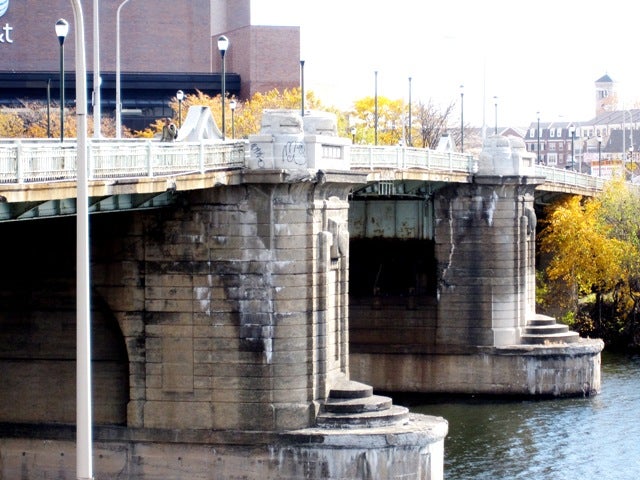City to begin South Street Bridge redo

Nov. 10
By Kellie Patrick Gates
For PlanPhilly
More than 18 years after design work began, Philadelphia is getting a new South Street bridge – a $67 million project re-imagined over the past two years with pedestrians and bicyclists in mind.
But with that gain, there will be pain: The bridge, which links University City and Center City via South Street and allows drivers to enter and exit The Schuylkill Expressway, will close when construction begins next month and stay closed throughout the roughly 2-year construction process.
Each day, 23,000 people take the bridge, said Charles Denny, chief traffic engineer with the city. Alternate car routes include the Chestnut and Walnut street bridges, he said. But Denny recommended that anyone who can use a different alternative: SEPTA. Carpooling and traveling a little earlier or later than peak rush hour would also be advised, he said.
The federal government will pick up the bulk of the $67 million tab – 80 percent. The state will pay 15 percent and the city 5 percent. When the bridge first went to design phase in 1995, the price tag was estimated at less than half that, in the low $30 million range, said Rina Cutler, the deputy mayor for transportation who used to work for PennDOT.
For most of those years, the project was waiting in line for funding, Cutler said.
Responding to a reporter’s question, Denny said it might take emergency vehicles taking alternative routes to hospitals a little longer to get there while construction takes place.
Mayor Michael Nutter interrupted, joking that the press corps must be grouchy because of the Eagles’ loss Sunday night. Yes, he said, there would be headaches, but the headaches would come with an infusion of money and construction jobs, and would end with a replacement for a bridge that is rated structurally deficient and that has rained chunks of concrete onto the expressway below.
“The South Street Bridge is a poster child for what happens when we do not invest in our cities and in our infrastructure,” Nutter said. He also lauded the process by which residents critiqued the original design by H2L2, formed a coalition to fight for changes, and then worked collaboratively with the city and state to develop a new, compromise design. “This process, as painful as it has been at times … could serve as a model for other projects in this city,” Nutter said.
Last spring, it was Nutter and State Sen. Vincent Fumo who convinced the city and state to hold off on the project until a compromise design could be developed, Terry Gillen, redevelopment authority executive director, said before the press conference.
The state was saying if the project didn’t start now that funding was in hand, it could lose that money, Gillen said. But Nutter agreed with residents that the design from the 1990s was “too car-centric” to be built now.
Nutter said that the pedestrian and bicycle friendly plan for the bridge reflects the city’s effort to become more green and healthy.
Among the changes and features:
• The bridge will have four traffic lanes instead of five. Bicycle lanes and sidewalks were widened.
• An additional crosswalk with a pedestrian activated traffic signal was added at the ramp and stair from the Bridge down to the Schuylkill River Park. The traffic signal will be portal mounted above the roadway. The curb ramps at this crosswalk will be widened to 6-ft. on both sides of the Bridge to allow multiple bicyclists to simultaneously cross and access the bicycle lanes.
• Speed Limit – The posted speed limit for the entire Bridge and viaduct was reduced from 30 to 25 MPH.
• Bicycle stop bars (stop bars are the thick, white lines at intersections that indicate where vehicles, motorized and otherwise, are to stop) will be advanced to allow bicyclists to get ahead of motorists for greater visibility and safety.
• Lighting will be done with pedestrians in mind. The majority of the bridge lighting will be sidewalk mounted at the curb. All light standards will include mounting brackets for future banner placement.
• Traffic signal timings have been optimized for pedestrian movements and safety.
• Reflective pavement markers will be installed at the curve on the east side to improve roadway visibility.
Changes were also made to make the bridge more visually appealing.
“We see the bridge as more a neighborhood bridge, connecting two historic neighborhoods, not a highway bridge,” said Marcia Wilkof, a member of the South Street Bridge Coalition and the Democratic ward leader of the 30th Ward. “We wanted the look and feel of it to reflect the historic context.”
The new bridge and viaducts – elevated roadways – will span about 2,000 feet. The roadway will cross over AMTRAK, CSX and SEPTA rail lines and pass under the CSX railroad high line. It will include new pedestrian entrances to the University City Regional Rail Station and University of Pennsylvania’s Hollenback Hall.
The project is the largest the city’s streets department has handled since it was created in the early 1950s, department chief engineer and surveyor David J. Perri said after the press conference.
Architectural renderings are not yet available for the new bridge, but are expected relatively soon, Perri said. It still has not been determined what the bridge towers will look like.
Contact the reporter at kelliespatrick@gmail.com



Contact the reporter at kelliespatrick@gmail.com
WHYY is your source for fact-based, in-depth journalism and information. As a nonprofit organization, we rely on financial support from readers like you. Please give today.



